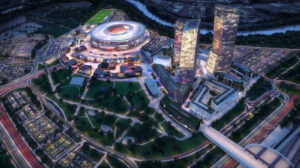Libeskind Studio Design advocates for inclusive architecture, creating accessible, culturally resonant spaces that unite communities.
Originally posted by Ahwatukee Foothills Magazine – An Interview with Zac Cohen on April 3, 2024
Inclusive Architecture: A Vision of Universality in Design
At Libeskind Studio Design, we firmly believe that architecture is a universal language that transcends boundaries and connects people from all walks of life. Gone are the days when grand architectural marvels were the exclusive domain of kings and queens. In our contemporary era, the democratization of architecture and design has unfolded, making exceptional spaces accessible and enjoyable for all. This evolution reflects our core ethos: architecture is for everyone.
Inclusive architecture, a principle that lies at the heart of our practice, is about creating spaces that are welcoming, functional, and meaningful for all individuals, irrespective of their capabilities or background. This approach is not just about adhering to accessibility standards; it’s about fostering a sense of belonging and bringing people together.
Physical Adaptations for Universal Enjoyment
Our dedication to universal design shines through the deliberate modifications we integrate into each of our projects. From ramps that fuse effortlessly with the surrounding landscape to tactile pathways that aid those with visual impairments, each component is carefully crafted. This ensures accessibility and enjoyment of the space by individuals of all abilities. We view this mindful approach not just as adherence to regulations but as a chance to push the boundaries of innovation and elevate the overall experience for everyone. Design doesn’t have to accommodate most; it must serve all!
Integrating Community Focus and Cultural Essence
At LSD, we don’t design in a vacuum. We understand that great architecture emerges from a deep connection with the community and a profound respect for local culture. Our design process begins with engaging community leaders and stakeholders, ensuring we capture the unique needs, aspirations, and cultural nuances of each area. This engagement is not just a preliminary step; it’s a cornerstone of our design philosophy.
We don’t see our projects as mere structures but as reflections of the community’s spirit and cultural identity. By listening closely to both the community and developers, we ensure our designs enhance properties and contribute positively to the broader community landscape. Our goal is to weave local cultural elements into the very fabric of urban life.
In this way, Libeskind Studio Design projects become more than buildings—they become integral parts of the communities they serve, celebrating and elevating the unique cultural landscape of each area.
Overcoming Zoning Challenges with Mixed-Use Spaces
Our advocacy for mixed-use developments is partly a response to the limitations imposed by traditional Euclidean zoning, which has historically segregated residential areas from commercial and industrial zones. This separation disrupts the organic integration of life’s various facets. By championing mixed-use spaces, we strive to reconcile these essential aspects of daily life, creating environments where living, working, and leisure coexist harmoniously. This approach not only fosters a vibrant community life but also contributes to the sustainability and economic vitality of the area.
Architecture as a Beacon of Inclusivity
In our journey to make architecture universally accessible and meaningful, we continually push the boundaries of design to ensure that our spaces are not just physically accessible but also culturally resonant and community oriented. By integrating physical adaptations, celebrating local cultures, and promoting mixed-use developments, we strive to create environments where everyone feels valued and included.
At Libeskind Studio Design, we envision a world where architecture serves as a beacon of inclusivity, reflecting the diversity and vibrancy of human life. Through our commitment to universal design, we continue to advocate for spaces that welcome all, proving that great architecture truly is for everyone.


